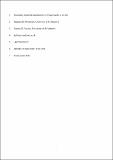Files in this item
Secondary dispersal mechanisms of winged seeds : a review
Item metadata
| dc.contributor.author | der Weduwen, Dagmar | |
| dc.contributor.author | Ruxton, Graeme D. | |
| dc.date.accessioned | 2020-06-18T23:34:44Z | |
| dc.date.available | 2020-06-18T23:34:44Z | |
| dc.date.issued | 2019-10 | |
| dc.identifier | 259356241 | |
| dc.identifier | 02c6089d-133c-4a50-977f-b45d803df57f | |
| dc.identifier | 85067465686 | |
| dc.identifier | 000485285900015 | |
| dc.identifier.citation | der Weduwen , D & Ruxton , G D 2019 , ' Secondary dispersal mechanisms of winged seeds : a review ' , Biological Reviews , vol. 94 , no. 5 , pp. 1830-1838 . https://doi.org/10.1111/brv.12537 | en |
| dc.identifier.issn | 1464-7931 | |
| dc.identifier.other | crossref: 10.1111/brv.12537 | |
| dc.identifier.uri | https://hdl.handle.net/10023/20105 | |
| dc.description.abstract | Winged seeds, or samaras, are believed to promote the long-distance dispersal and invasive potential of wind-dispersed trees, but the full dispersive potential of these seeds has not been well characterised. Previous research on the ecology of winged seeds has largely focussed on the initial abscission and primary dispersal of the samara, despite it being known that the primary wind dispersal of samaras is often over short distances, with only rare escapes to longer distance dispersal. Secondary dispersal, or the movement of the seeds from the initial dispersal area to the site of germination, has been largely ignored despite offering a likely important mechanism for the dispersal of samaras to microhabitats suitable for establishment. Herein, we synthesise what is known on the predation and secondary dispersal of winged seeds by multiple dispersive vectors, highlighting gaps in knowledge and offering suggestions for future research. Both hydrochory and zoochory offer the chance for samaroid seeds to disperse over longer distances than anemochory alone, but the effects of the wing structure on these dispersal mechanisms have not been well characterised. Furthermore, although some studies have investigated secondary dispersal in samaroid species, such studies are scarce and only rarely track seeds from source to seedling. Future research must be directed to studying the secondary dispersal of samaras by various vectors, in order to elucidate fully the invasive and colonisation potential of samaroid trees. | |
| dc.format.extent | 9 | |
| dc.format.extent | 615539 | |
| dc.language.iso | eng | |
| dc.relation.ispartof | Biological Reviews | en |
| dc.subject | Secondary dispersal | en |
| dc.subject | Samara | en |
| dc.subject | Anemochory | en |
| dc.subject | Winged seed | en |
| dc.subject | Diplochory | en |
| dc.subject | QH301 Biology | en |
| dc.subject | SB Plant culture | en |
| dc.subject.lcc | QH301 | en |
| dc.subject.lcc | SB | en |
| dc.title | Secondary dispersal mechanisms of winged seeds : a review | en |
| dc.type | Journal item | en |
| dc.contributor.institution | University of St Andrews. School of Biology | en |
| dc.contributor.institution | University of St Andrews. University of St Andrews | en |
| dc.contributor.institution | University of St Andrews. Centre for Biological Diversity | en |
| dc.identifier.doi | 10.1111/brv.12537 | |
| dc.description.status | Peer reviewed | en |
| dc.date.embargoedUntil | 2020-06-19 |
This item appears in the following Collection(s)
Items in the St Andrews Research Repository are protected by copyright, with all rights reserved, unless otherwise indicated.

